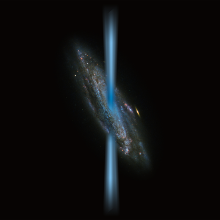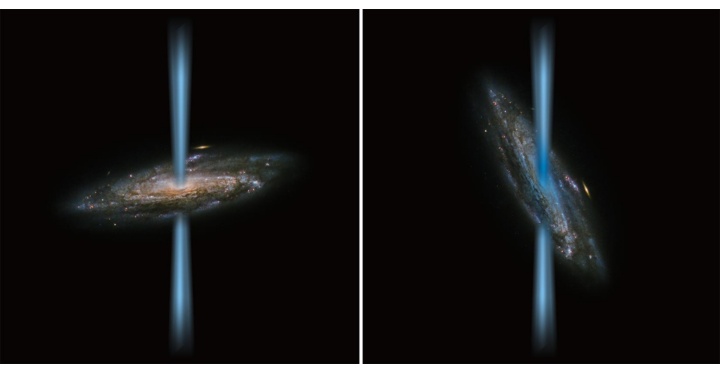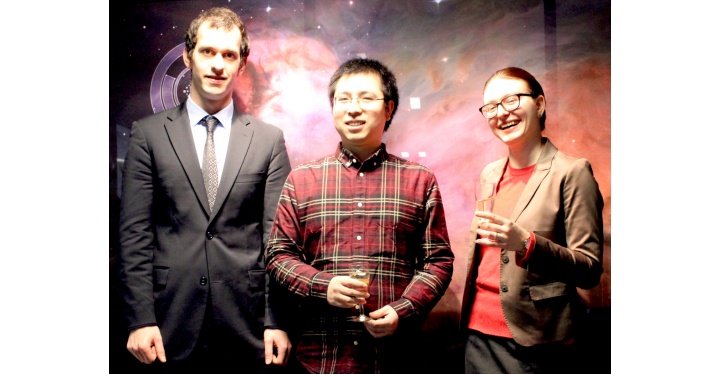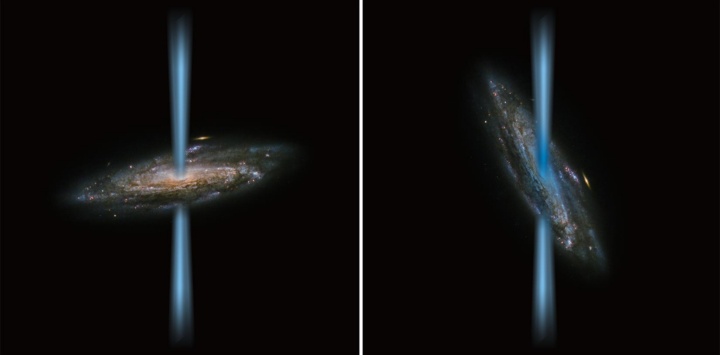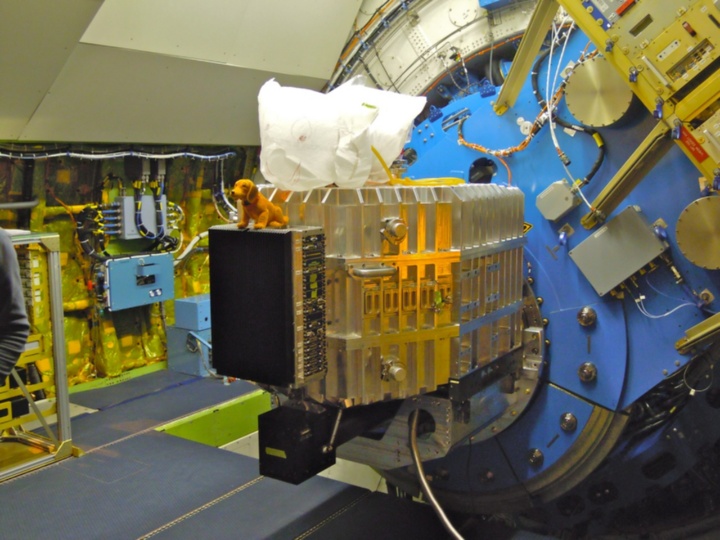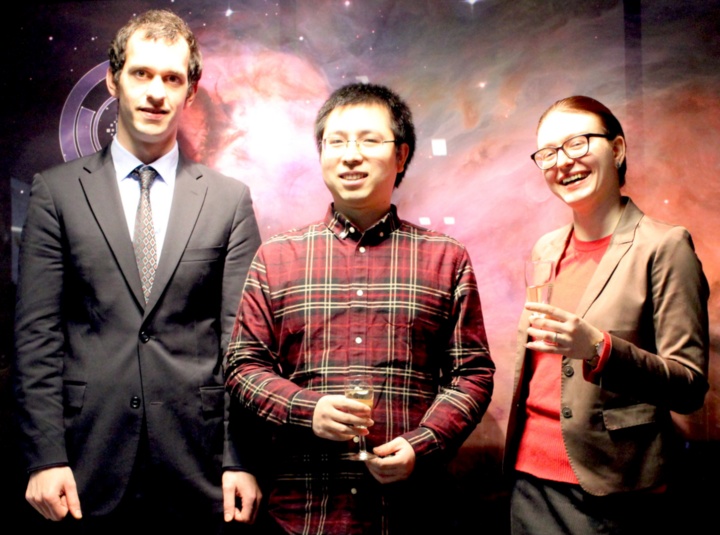Scientists using the FIFI-LS instrument onboard SOFIA found a peculiar black hole, which seems to change its galactic surrounding in a way that usually is associated with newborn stars.
Active Galactic Nuclei (AGN) are powered by the accretion of material onto black holes at the center of galaxies. As these massive black holes consume gas and dust, some of that material is ejected outward as jets of high-energy particles and radiation, which are suspected to influence the conditions for star formation in their host galaxies.
Stars are born deep inside celestial clouds of dust and gas, a process hidden from our view in visible light. However, infrared light, which our eyes cannot see, can penetrate these clouds. Infrared telescopes like SOFIA, for example, can see through these clouds, letting astronomers study the star formation process. In particular, they hunt for the infrared signature of ionized carbon that is produced during the formation of stars: The more stars are formed, the more ionized carbon is produced. The infrared emission of the ionized carbon line [CII]158 µm can escape the gas and dust clouds in which stars are formed. Hence, scientists would like to use the strength of this line to measure the star formation rate in the Milky Way, nearby galaxies, or even distant galaxies.
Unfortunately, Astronomers still do not fully understand the intimate link between AGNs - and the respective massive black holes - to their host galaxies, especially how they influence the galactic star formation. Therefore, the Close AGN Reference Survey (CARS), which includes 39 nearby AGNs, aims to provide the most detailed view of black holes' influence on the star formation processes inside galaxies.
Therefore, a scientific team led by Irina Smirnova-Pinchukova, from the Max Plank Institute for Astronomy in Heidelberg, Germany, studied five CARS galaxies using the Field Imaging Far-Infrared Line Spectrometer (FIFI-LS) onboard of SOFIA. One galaxy named HE 1353-1917 harbors a quite special black hole in its center, which ejects its jet directly into the galactic plane instead of perpendicular to it as “normal” black holes do.
Additionally, HE 1353-1917 shows a [CII]158 µm concentration which is ten times larger than in other galaxies of similar size and composition.
On the other hand, the star formation rate that has been derived using other indicators is only able to produce 25% of the detected amount of ionized carbon. In other words, newborn stars alone could not explain the detected strong abundance of ionized carbon. Since most of the measured ionized carbon in HE 1353-1917 is concentrated near the galaxy’s active black hole, this indicates that the high [CII]158 µm concentration is closely connected with the high energy jet produced by the black hole in the galaxy’s center.
Like newborn stars, this jet seems to heat up and ionize the gas around the galaxy's center and hence is increasing the measured amount of the [CII]158 µm line emission. Consequently, scientists may have to reevaluate their ideas about ionized carbon just being a key indicator of star formation, and about how black holes affect their host galaxies generally. “The black hole’s jet orientation is so peculiar,” says Irina Smirnova-Pinchukova. “It transforms the surroundings in the same way newborn stars would, but stars alone could not cause what we observed.” The results of their observations are published in the journal Astronomy and Astrophysics in May 2019.
“Before we can use this line as a reliable indicator for star formation in distant galaxies we need to understand all processes that may influence the measured strength of the [CII]158 µm emission in star-forming regions in the center of local galaxies”, co-author Christian Fischer from the German SOFIA Institute of the University of Stuttgart explains.
On November 29th, 2019 Irina Smirnova-Pinchukova obtained the Ernst Patzer Preis. This prize is annually awarded to young scientists at the Max-Planck-Institute for Astronomy (MPIA) and other institutes in Heidelberg. The prize is awarded to astronomical articles published in a renowned peer-reviewed journal by PhD students or young Post-docs.
“This publication was only possible by the major support of my PhD supervisor Bernd Husemann and by the great support of my co-authors”, Irina Smirnova-Pinchukova mentions.
Further Links:
- “The Close AGN Reference Survey (CARS): Discovery of a global [Cii] 158μm line excess in AGN HE 1353−1917”, Smirnova-Pinchukova et al. A&A 626, L3, 06/2019https://arxiv.org/pdf/1905.10383.pd
- CARS Sample : https://www.cars-survey.org/?q=node/3
- Patzer Award 2019: https://www.mpia.de/5012887/2019_11_29_Patzer_e
Further SOFIA Links
- SOFIA Science Center
- NASA SOFIA Missions Page
- DLR SOFIA Project Page
- DLR Blogs for SOFIA
- SOFIA Missions Page at DLR Space Administration (German)
- DSI SOFIA Image Gallery (in German)
SOFIA, the "Stratospheric Observatory for Infrared Astronomy" is a joint project of the Deutsches Zentrum für Luft- und Raumfahrt e.V. (DLR; German Aerospace Center, grant: 50OK0901, 50OK1301 and 50OK1701) and the National Aeronautics and Space Administration (NASA). It is funded on behalf of DLR by the Federal Ministry for Economic Affairs and Energy based on legislation by the German Parliament, the State of Baden-Württemberg and the University of Stuttgart. Scientific operation for Germany is coordinated by the German SOFIA-Institute (DSI) of the University of Stuttgart, in the USA by the Universities Space Research Association (USRA).


